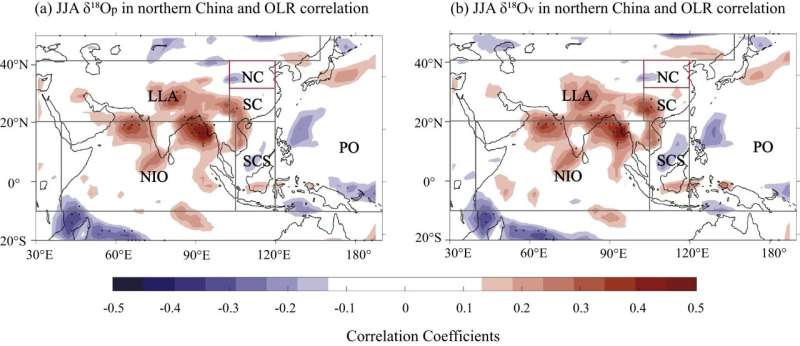This article has been reviewed according to Science X's editorial process and policies. Editors have highlighted the following attributes while ensuring the content's credibility:
fact-checked
peer-reviewed publication
trusted source
proofread
Impact of moisture sources on variability of precipitation oxygen isotopes in northern China

In a study published in npj Climate and Atmospheric Science, a joint research group from the Institute of Earth Environment of the Chinese Academy of Sciences, the Stockholm University, and the California State University found that while land recycled water vapor contributes more than 60% to precipitation in northern China, the precipitation δ18O (δ18Op) is primarily influenced by the relative contribution of oceanic moisture.
For decades, precipitation δ18O (δ18Op) has been an important proxy for reconstructing past climate change. However, its interpretation, especially under the influence of the East Asian Summer Monsoon (EASM), has been controversial. In northern China, located at the margin of the EASM region, the more continental climate raises questions about the impact of different moisture sources on δ18Op.
To explore the complexity of moisture source variability and its impact on δ18Op, the researchers used a general circulation model the Community Atmosphere Model version 3 (CAM3), enhanced with water-tagging and stable water isotope modules, to quantitatively trace water vapor from its source to northern China.
They found that more than 60% of the precipitation in northern China originated from local recycled moisture and other terrestrial water vapor. However, this substantial contribution had a minimal effect on δ18Op values, indicating a predominant transpiration over evaporation.
They suggested that despite the high percentage of terrestrial moisture, the δ18Op was predominantly affected by oceanic moisture sources, with the Pacific Ocean (24.4%) and the North Indian Ocean (13.0%) being crucial contributors.
In addition, the researchers highlighted the role of the Pacific Decadal Oscillation in modulating δ18Op by altering the moisture contributions of the Pacific Ocean and North Indian Ocean.
Interestingly, local precipitation patterns show an inverse phase variation with δ18Op, highlighting the complex dynamics between local moisture recycling and the large-scale oceanic influences.
These findings are valuable for understanding past climate variability and provide a new lens through which to view the complex climate systems of monsoonal China.
More information: Fangyuan Lin et al, Seasonal to decadal variations of precipitation oxygen isotopes in northern China linked to the moisture source, npj Climate and Atmospheric Science (2024). DOI: 10.1038/s41612-024-00564-x
Journal information: npj Climate and Atmospheric Science
Provided by Chinese Academy of Sciences




















